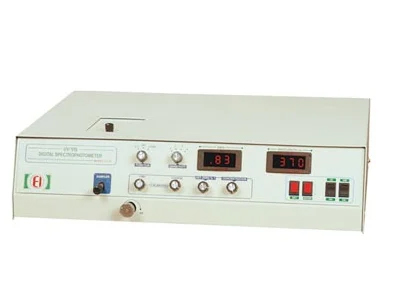-
Call
+ 91 9869569782 / 9594079782
-
Email
Spectrophotometer
Spectrophotometer Manufacturer, Supplier

What is a spectrophotometer?
A spectrophotometer is a scientific instrument used to measure the amount of light absorbed or transmitted by a sample as a function of wavelength. It is a fundamental tool in various scientific disciplines, including chemistry, biochemistry, biology, physics, environmental sciences, and more. Spectrophotometers work based on the principles of spectrophotometry, which involves the interaction of light with matter.
The basic principle behind a spectrophotometer is the Beer-Lambert Law, which states that the absorbance of light by a sample is directly proportional to the concentration of the absorbing species and the path length of the sample. In other words, the more concentrated a substance is in the sample, the more light it will absorb, and the higher its absorbance will be.
Components of a Spectrophotometer:
A spectrophotometer consists of several essential components that work together to measure the absorbance or transmission of light by a sample.
- 1. Light Source: The light source provides the radiation that passes through the sample. Tungsten filament lamps, deuterium lamps (for UV), and light-emitting diodes (LEDs) are common light sources used in spectrophotometers.
- 2. Monochromator: The monochromator is responsible for dispersing the light into its component wavelengths and selecting the desired wavelength for analysis. It typically consists of a prism or diffraction grating.
- 3. Sample Compartment: The sample compartment holds the sample and ensures proper alignment with the light beam. Cuvettes made of quartz or glass are commonly used to contain the sample.
- 4. Detector: The detector captures the light transmitted through the sample and converts it into an electrical signal. Photodiodes, photomultiplier tubes (PMTs), and charge-coupled devices (CCDs) are commonly used detectors in spectrophotometers.
- 5. Data Processing Unit: The data processing unit processes the electrical signal from the detector, calculates the absorbance, and displays or records the results. Modern spectrophotometers often have built-in computers and software for data analysis.
Types of Spectrophotometers:
Spectrophotometers come in various configurations to cater to specific needs and applications.
- 1. Single-Beam Spectrophotometer: In a single-beam spectrophotometer, the sample and reference measurements are taken sequentially, resulting in slightly longer analysis times. This type of spectrophotometer is more affordable and commonly used for routine measurements.
- 2. Double-Beam Spectrophotometer: Double-beam spectrophotometers have two separate light paths—one for the sample and the other for the reference. Simultaneous measurement of sample and reference minimizes errors due to fluctuations in light source intensity and ensures higher accuracy.
- 3. Split-Beam Spectrophotometer: Split-beam spectrophotometers split the light into two beams—one for the reference and another for the sample. This design allows for better long-term stability and higher precision.
- 4. Array-Based Spectrophotometer: Array-based spectrophotometers use an array of detectors or pixels to measure the entire spectrum simultaneously. This significantly reduces measurement time and is particularly useful for kinetic studies and rapid-scanning applications.
- 5. Cuvette-Based vs. Fiber-Optic Spectrophotometers: Cuvette-based spectrophotometers use cuvettes to hold liquid samples, making them ideal for liquid measurements. Fiber-optic spectrophotometers, on the other hand, allow non-contact measurements and can analyze solid samples or samples in remote locations.
Applications:
- Quantitative Analysis: Spectrophotometers are extensively used for quantitative analysis in chemistry, biochemistry, and pharmaceutical industries. They determine the concentration of specific substances in a sample by measuring their absorbance and following the Beer-Lambert Law.
- Qualitative Analysis: Spectrophotometry aids in qualitative analysis by identifying unknown substances based on their characteristic absorption spectra. It enables researchers to distinguish between different compounds and functional groups.
- DNA and Protein Analysis: UV-Vis spectrophotometers are commonly employed in DNA and protein analysis. They assess the purity, concentration, and quality of nucleic acids and proteins, crucial for genetic research and biotechnology applications.
- Environmental Monitoring: Spectrophotometers play a significant role in monitoring water quality, air pollution, and soil contamination. They help detect pollutants and assess environmental impact, ensuring safer ecosystems.
- Pharmaceutical Quality Control: In the pharmaceutical industry, spectrophotometry is essential for assessing the concentration of active pharmaceutical ingredients (APIs) and identifying impurities, ensuring drug safety and efficacy.
- Food and Beverage Industry: Spectrophotometers are used to analyze food color, quality, and nutritional content, ensuring compliance with industry standards and regulations.
- Materials Characterization: Spectrophotometry is crucial for characterizing materials such as coatings, thin films, and nanomaterials. It provides information about their optical properties and helps in material research and development
Benefits:
- Accurate and Reliable: Spectrophotometers offer precise and repeatable measurements, ensuring reliable data for various applications.
- Non-Destructive: Spectrophotometry is a non-destructive technique, allowing multiple measurements without degrading the sample.
- Versatile: With different types of spectrophotometers available, the technique can analyze a wide range of samples, including liquids, solids, and gases.
- Sensitivity: Spectrophotometers can detect even minute amounts of substances, making them suitable for trace analysis and high sensitivity applications.
- Time-Efficient: Modern spectrophotometers provide rapid analysis, saving time in research and industrial processes.
- Quality Control: In manufacturing industries, spectrophotometers ensure quality control, reducing production defects and maintaining consistency in products.
- Cost-Effective: Spectrophotometry eliminates the need for complex and expensive analytical techniques in many applications, making it a cost-effective solution.
Spectrophotometry is a vital analytical technique with widespread impact in scientific research and industry. Aditi Associates, a leading Spectrophotometer Manufacturer and Exporter, plays a crucial role in advancing the field with cutting-edge technology. With versatile applications across various disciplines, spectrophotometers have become essential tools for accurate analysis. Aditi Associates' commitment to quality empowers scientists worldwide with state-of-the-art instruments, driving scientific exploration and problem-solving. As technology evolves, advancements in spectrophotometry promise even greater possibilities. Overall, spectrophotometry remains pivotal in advancing our understanding of the natural world and addressing complex challenges.
Request A Quote